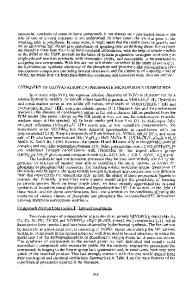The Hydrothermal Synthesis of Lithium Iron Phosphate
- PDF / 304,606 Bytes
- 6 Pages / 612 x 792 pts (letter) Page_size
- 66 Downloads / 364 Views
0972-AA13-08
The Hydrothermal Synthesis of Lithium Iron Phosphate Jiajun Chen and M. Stanley Whittingham Chemistry Department, Binghamton University, Binghamton, NY, 13902
ABSTRACT Well-crystalline LiFePO4 particles were successfully prepared in the temperature range between 120 and 220°C, and complete ion ordering was obtained above 175°C where the unit cell dimensions were identical to high temperature material. The use of a soluble reductant, such as sugar or ascorbic acid, was found to minimize the oxidation of the iron to ferric. The electronic conductivity was enhanced by the deposition of carbon from the sugar, or by the addition of carbon nanotubes to the hydrothermal reactor when over 90% of the lithium could be de-intercalated electrochemically. We have extended the hydrothermal synthesis method to the Mn, Co and Ni analogs as well as to the mixed phosphates, such as LiMnyFe1-yPO4. INTRODUCTION Lithium iron phosphate, with the Olivine structure is under serious consideration for a number of lithium battery applications, and has recently been commercialized in power tools by A123 Corp. This material is of particular interest because of its low cost, low toxicity and probable safety in charged cells. Originally worked on by Padhi et al [1], many researchers around the world have been trying to overcome its low electronic and ionic conductivity which are perceived to impact its power capability. The use of a conductive coating [2-5], whether of carbon or possibly of iron phosphide, is allowing attainment of the complete capacity and at high rates. Two remaining challenge are to how to make this material by a low cost process, and to make the higher potential LiMnPO4 operative at normal discharge and charge rates [6]. We showed in 2001 that LiFePO4 can be formed by a hydrothermal process [7]. However, it did not attain 100% capacity, and in 2002 we reported that there was 7-8% iron on the lithium site [8], and that these iron ions probably hindered lithium diffusion in the tunnel structure. Also in 2002 Shoji et al [9] reported that they made a narrow particle size distribution LiFePO4 by a hydrothermal process. In 2004 Nespard et al [10] reported that they could make narrow distribution LiFePO4 by a hydrothermal process. In 2006 we reported [11] that hydrothermally formed LiFePO4 can attain close to 100% capacity in lithium cells at room temperature. In this paper we describe the hydrothermal process, and how it can be extended to many other divalent lithium metal phosphates either with one metal atom or a broad mixture of metal atoms.
EXPERIMENT The LiFePO4 was prepared by hydrothermal reaction in a Parr reactor as described previously [11]. Specifically the starting materials were FeSO4 · 7H2O (98% Fisher), H3PO4 (85 wt% solution Fisher), LiOH (98% Aldrich). The molar ratio of the Li:Fe:P was 3:1:1, and a typical concentration of FeSO4 was 22 g/liter of water. Sugar and/or l-ascorbic acid (99% Aldrich) was added as an in situ reducing agent to minimize the oxidation of ferrous to ferric; 1.3 g/liter was
Data Loading...











